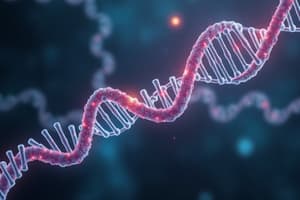Podcast
Questions and Answers
Which of the following nucleobases is classified as a less common purine?
Which of the following nucleobases is classified as a less common purine?
- Xanthine (correct)
- Thymine
- Cytosine
- Uracil
Which pairs of nucleobases represent the two groups of nitrogenous bases?
Which pairs of nucleobases represent the two groups of nitrogenous bases?
- Adenine and Guanine (correct)
- Adenine and Cytosine
- Xanthine and Hypoxanthine
- Cytosine and Uracil
What is the classification of Hypoxanthine among nitrogenous bases?
What is the classification of Hypoxanthine among nitrogenous bases?
- Pyrimidine
- Common purine
- Non-nucleobase
- Less common purine (correct)
In the context of nitrogenous bases, which statement is correct?
In the context of nitrogenous bases, which statement is correct?
Which of the following bases is not categorized as a purine?
Which of the following bases is not categorized as a purine?
What did Erwin Chargaff contribute to our understanding of nucleic acids?
What did Erwin Chargaff contribute to our understanding of nucleic acids?
Which scientists utilized X-ray diffraction to study the structure of nucleic acids?
Which scientists utilized X-ray diffraction to study the structure of nucleic acids?
Which statement correctly describes the interaction of nitrogen atoms in the bases of nucleic acids?
Which statement correctly describes the interaction of nitrogen atoms in the bases of nucleic acids?
What did Rosalind Franklin's X-ray diffraction studies reveal about nucleic acids?
What did Rosalind Franklin's X-ray diffraction studies reveal about nucleic acids?
What role do carbonyl oxygen atoms play in the context of nucleic acid structure?
What role do carbonyl oxygen atoms play in the context of nucleic acid structure?
Flashcards are hidden until you start studying
Study Notes
Nitrogenous Bases (nucleobases)
- Divided into two groups: purines & pyrimidines
- Less common purines: Xanthine (X) and Hypoxanthine (Hx)
Nucleic Acid Structure
- Erwin Chargaff: Found Chargaff’s rules
- Rosalind Franklin & Maurice Wilkins: Used X-ray diffraction to reveal the structure of DNA
- The nitrogen (N) atoms in the bases donate hydrogen atoms, while the carbonyl oxygen (=O) and nitrogen (=N) atoms accept them.
- This orientation is important because it affects how strands interacts
- If these rules are not observed, the molecule is likely not double-stranded DNA, which is crucial for maintaining genetic integrity.
Forces that Stabilize DNA Structure
- Hydrogen Bonding:
- Although individually weak, these bonds are additive & collectively provide significant stability to double-stranded DNA (dsDNA)
- Coaxially Stacked Arms (tertiary structure)
- Within the nucleosomes the major part of DNA is wrapped around histone subunits called nucleosomes
- Main protein family around which DNA is wrapped.
Studying That Suits You
Use AI to generate personalized quizzes and flashcards to suit your learning preferences.




